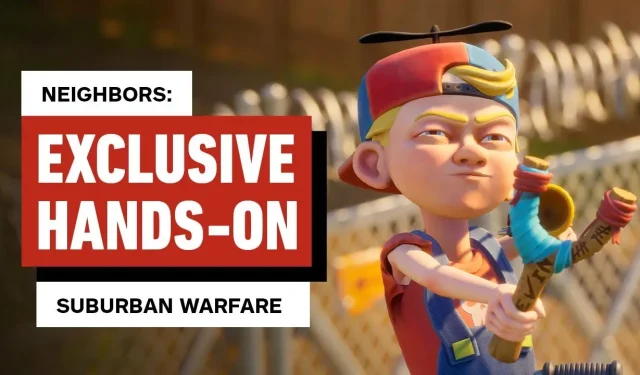The gaming landscape continues to evolve, and every now and then, a title emerges that defies categorization. “Neighbors: Suburban Warfare” is one such game, blending elements from diverse genres into an anarchic multiplayer experience. This article delves into the core features, gameplay mechanics, and the overall charm of this unique title, forecasted to capture the interest of gamers looking for something fresh and entertaining.
An Unconventional Multiplayer Experience
“Neighbors: Suburban Warfare” sets itself apart with its combination of arcade-style shooting and light tactical base-building mechanics. Drawing influence from popular games like Team Fortress, the gameplay retains a fun, competitive edge while inviting players to explore strategic layers reminiscent of survival games. This duality makes it accessible for casual gamers but offers deeper systems that more competitive players can appreciate and master over time.
The slapstick humor reminiscent of titles like Goat Simulator and Just Die Already adds a layer of absurdity to the gameplay, with whimsical character designs and chaotic scenarios creating a playful atmosphere. Players are not just fighting battles; they’re engaging in a series of delightful, unpredictable encounters that keep the experience lively and entertaining. The aesthetics of the game, featuring a post-World War II world that appears friendly and light-hearted, further enhance its unique charm.
A Unique Blend of Genres
A key aspect of “Neighbors: Suburban Warfare” is how it masterfully interweaves multiple gaming genres. The arcade shooter elements immediately draw players in with fast-paced action while the base-building mechanics allow for tactical depth. This combination not only caters to varied player preferences but also encourages collaboration and competition among teammates, fostering a community-centric gaming environment.
Moreover, the game’s lighthearted take on combat showcases an innovative approach—a deliberate move away from hyper-realistic violence towards a more humorous depiction of conflict. This creative direction opens up avenues for both creativity and fanatic battles, allowing players to engage without the serious undertones often associated with traditional shooters. As such, “Neighbors: Suburban Warfare” presents a refreshing alternative in the multiplayer gaming sphere, emphasizing fun above all else.
Cultural Relevance of Humor in Gaming
The rise of absurdist humor in video games reflects a cultural shift in how narratives and comedic elements are interwoven into interactive entertainment. Titles such as “Neighbors: Suburban Warfare” exemplify this trend, inviting players to laugh while they strategize. The intertwining of humor and gameplay creates a unique platform that allows for social commentary while maintaining a light-hearted approach. In a world where gaming can sometimes take itself too seriously, this game serves as a reminder of gaming’s potential for whimsical joy.
Furthermore, the game’s post-WWII setting, although playful, invites players to reflect on the absurdity and chaos that can arise in conflict, cleverly contrasting the grim realities of war with humor. This dichotomy not only amplifies the entertainment value but also cements its relevance in contemporary gaming culture, where laughter can often be a coping mechanism for real-world complexities.
Conclusion
“Neighbors: Suburban Warfare” promises a fresh take on multiplayer gaming by fusing chaotic fun with strategic gameplay mechanics. Its unique blend of humor, post-war aesthetics, and community-driven competition creates an inviting environment for both casual and hardcore gamers alike. As the gaming world continues to diversify, the question arises: could this game pave the way for more titles that prioritize humor and light-hearted gameplay? With its visionary design and engaging mechanics, ‘Neighbors: Suburban Warfare’ very well may redefine how we engage with multiplayer games in the future.
https://www.youtube.com/watch?v=z9t3QEuJMsM


